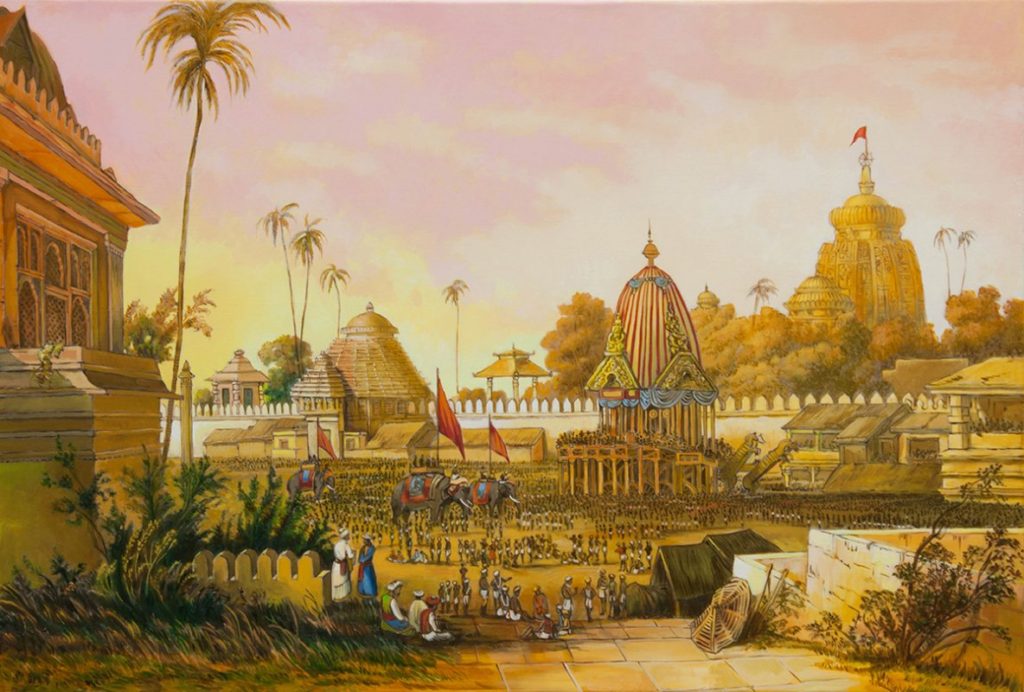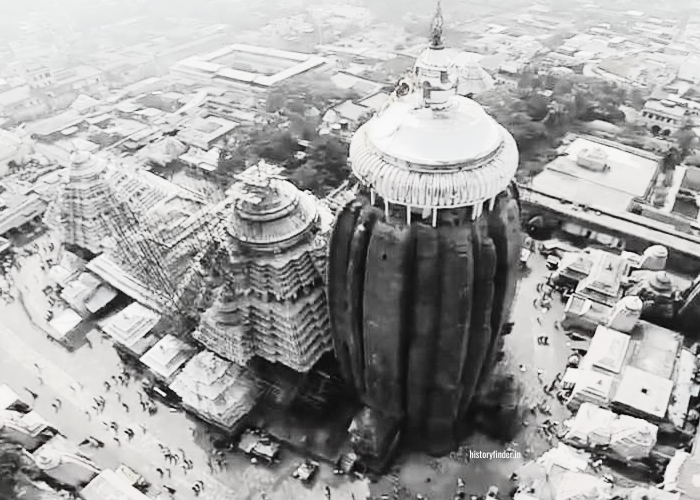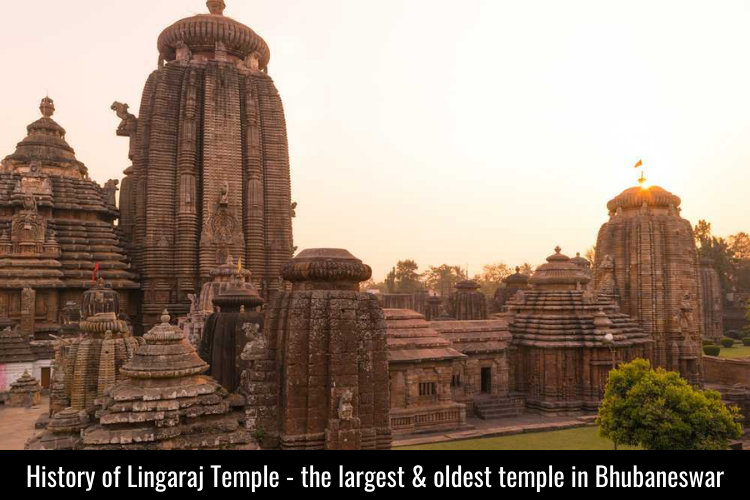Jagannath Temple of Puri is one of the most iconic Hindu temples in Odisha. Although the state of Odisha is extremely rich with old ancient temples, but Puri Jagannath Temple has a very high reputation in the eastern India. The famous Hindu temple also counts among the oldest temples in Odisha. Beside its religious reputations, Puri Jagannath teample is a represntation of fabulous Kalinga architectural style and culture with a rich history of almost 900 years. Jagannath Temple is also famous for Puri Ratha Yatra, one of the oldest Hindu cultural and religious festivals in India.
One of the main highlights of the temple is the towering Jagannath Rath Yatra, which is held annually and attracts millions of devotees from all over the world. During this grand festival, the deities of Lord Jagannath, Balabhadra, and Subhadra are placed on elaborately decorated chariots and pulled through the streets, symbolizing the deities’ journey to their aunt’s house.
Lord Jagannath is a form of Lord Vishnu, one of the three principle deities of Hinduism. The word Jagannath is made of two words- ‘Jaga’ means the universe, while ‘nath’ stands for the Lord. Although the Lingaraj Temple of Bhubaneswar is the largest temple of Odisha, Puri Jagannath Temple is far behind in terms of size. The Jagannath Temple of Puri, however, is more famous in terms of popularity.
Puri Jagannath Temple visit brings a deeply spiritual experience to the Hindu devotees. The bhoga or Mahaprasada of Jagannath Temple has a significant religious value to the temple visitors. Apart from its religious significance, the temple also serves as an important cultural and social center. Puri Jagannath Temple Bhog Mandapa, the largest open air kitchen in the world, feeds about 100,000 people each day.
History of Puri Jagannath Temple
Puri Jagannath Temple has a rich history of ancient Kalinga cultures and architectures. Several rituals and worshipping practices of Jagannath Temple are many centuries old and unique. Starting from cooking practices of Mahabhoga up to annual Ratha Yatra of Puri, all signifies the rich cultural heritage and history of ancient kingdoms of Odisha.
Foundation of Jagannath Temple
The 900 years old Puri Jagannath Temple history dates back to the reign of the Eastern Ganga Dynasty. King Anantavarman Chodaganga Deva, who also was the founder of Eastern Ganga Dynaty at Puri, founded Jagnnath Temple in early 12th century. His subsequent rulers also made significant contributions to the temple, enhancing its grandeur and splendor. A copper-plate inscription by his descendant Narasinghadeva II mentions about the foundation of Puri Jagnannath Temple by King Anantavarman Chodaganga Deva. The 1134–1135 CE inscription also records the donations of King Narasinghadeva II, to the temple.

King Anantavarman probably constructed only Jaga mohan (assembly hall) and Vimana (the chariot) of Jagannath Temple. His successor, King Anangabhima Deva completed the construction of the remaining structures in 1174 CE.
Invasions at Jagannatha Temple
The temple had received huge donations time to time from several Hindu kings. Puri Jagannath Temple, therefore, accumulated a huge wealth and hence had been among the richest temples in the country throughout its history. It also induced several invaders tried to plunder Jagannath Temple wealth in different period. The ‘Madalapanji’, a chronicle of 12th century on Jagannath Temple that has records of several incidents of invasion.
The history of Puri Jagannath Temple of Odisha has a record of 18 invasions in different periods.
- Invasion-1: by Raktavahu, the Rashtrakuta ruler, but before the present temple was built.
- Invasion-2: by Illias Shah, the Sultan of Bengal in 1340 CE.
- Invasion-3: by Feroze Shah Tughlaq, the Sultan of Delhi in 1360 CE.
- Invasion-4: by Ismail Ghazi in 1509 CE. He was the supreme commander of Allauddin Hussain Shah, the Sultan of Bengal.
- Invasion-5: by Kalapahara in 1568 CE.
- Invasion-6: by Suleman and Osman. Suleman was the son of Kuthu Shah whereas Osman was the son of Isha, the ruler of Odisha.
- Invasion-7: by Mirza Khurrum, the commander of Islam Khan in 1601 CE. Islam Khan was the Nawab of Bengal.
- Invasion-8: by Hasim Khan in 1608 CE, the Subedar of Odisha.
- Invasion-9: by Kesodasmaru who was a jagirdar and a Hindu Rajput. However, the timeline is unknown of this invasion.
- Invasion-10: by Kalyan Malla in 1611 CE. He was the son of Raja Todar Mall.
- Invasion-11: second attempt by Kalyan Malla. Next year in 1612 CE.
- Invasion-12: by Mukarram Khan in 1617 CE.
- Invasion-13: by Mirza Ahmad Beg. Beg was the nephew of Nurjahan, wife of Jahangir.
- Invasion-14: by Amir Mutaquad Khan in 1641 CE.
- Invasion-15: by Amir Fateh Khan in 1647AD.
- Invasion-16: by Ekram Khan in 1699 CE. Ekram Khan was the Nawab of Odisha.
- Invasion-17: by Muhammad Taqi Khan in 1731 CE.
- Invasion-18: by the followers of Alekh religion in 1881 CE. [source: tutorialspoint.com]
In 1692, Mughal emperor Aurangzeb ordered to close and demolish the temple. But the Mughal officials didn’t damage the temple much on request of locals. However, the Mughals closed the temple until death of Aurangzeb in 1707.
Jagannath Temple Architecture
The architecture of Puri Jagannath Temple represents the classic 12th century Kalinga Temple Architecture. The word ‘Kalinga’ however refers the ancient state of Odisha. Such elementary form of Temple Architectures, used at Puri Jagannath Temple, is known as Deula. The temple premise covers a total area of more than 400,000 square feet. Meghanada Pracheer, a 20 feet high outer peripheral wall, surrounds Jagannath Temple. There is one more internal wall, Kurma Bedha, surrounds the main temple of Jagannath only.
Puri Jagannath Temple consists of four primary structures namely- the main temple or Vimana, the Jag amohana (assembly hall), the Nata Mandir (festival hall), and the Bhog Mandir (kitchen). Each structure showcases exquisite craftsmanship and attention to detail. Lingaraj temple of Bhubaneswar has the similar Kalinga Deula architectural style in it.

The four main structures of the temple were constructed in west-east axis. The tallest structure or Vimana appears at the back, to the western end. Remaining three structures apprear on the axial line, in a decreasing order of height. The Puri temple structure shows the full-fledged Odishan fourvertical divisions that are Pitha (pedestal), the Bada (wall), the Gandi (trunk) and the Mastaka (the head). The main temple .
The Four Main Structures
Puri Jagannath Temple Vimana is the highest structure in Odisha, rises to a height of 65 meters. The structure is also called Bada Deula or Garbha Griha, which is actually the Sanctum, constructed on an elevated platform. The idols of the Puri Jagannath Temple deities are installed on the Ratnavedi or the Throne of Pearls. The curvilinear spire of Vimana, also known as Rekha Deula, constructed over Pancharatha (five pagas or segments). The five pagas have their specific names which are- Raha (the middle paga), Anuraha (the two flanking pagas) and Kanika (the two corner pagas). An eight spoked wheel, known as Neelachakra, appears at the top of Vimana.
Jagmohan or Mukhshala, the frontal porch of the temple, is the second structure in the axial line. It serves as the temple assembly hall for the devotees. Jogmohan represents a Pidha Deula structure, which is basically a square structure with a pyramidal spire.
Natamandir is the next structure, appearing to the further east of Jagamohan. It typically serves as the temple audience or dancing hall. Next structure is the Bhogmandap or the offering hall of the temple.
Other Important Structures at Puri Jagannath Temple
Puri Jagannath Temple houses many other small temples that worships several other deities. The Vimala temple, Shakti Pith and Mahalakshmi Temple are the most significant ones among the other structures. Regular prayers and other rituals are duly performed in all other temples inside Puri Jagannath Temple.
Cultures of Puri Jagannath Temple
Puri Jagannath Temple Committee had been proudly following the old cultural practices for centuries. The cultural heritage of Puri Jagannath Temple reflects through its auspicious festivals.
History of Nabakalebara Festival
Nabakalebara is the first major festival of Odiya calendar and also one of the major festivals of Puri Jagannath Temple. The famous festival of Nabakalebara marks the unique rebirth of the Lord Jagannath and his transmigration from one body to another. The ritual is performed every 8th, 12th, or 19th year to the previous Nabakalebara, in Odiya month of Ashada (3rd month of Odiya calendar) month. The month of two full moons in the adhimasa year marks the auspicious time for the ritual.
The history of Nabakalebara Festival at Puri Jagannath Temple dates back to 1575 CE. Yaduvanshi Bhoi King Ramachandra Deva began the tradition of the grand festival. The rituals of Nabakalebara involves the recreation of the wooden idols of four Hindu deities (Jagannath, Balabhadra, Subhadra, and Sudarshana) at Jagannath Temple, Puri. All the four deities leave their old oldies and transmigrate to their new bodies through this ritual. This event further involves installation of new idols in the Jagannath Temple and burial of the old ones in the temple premises at Koili Baikuntha.
History of Puri Jagannath Ratha Yatra Festival
History of Puri Jagannath Ratha Yatra festival is not as old as the temple itself. First Ratha Yatra at Jagannath Temple of Puri started in 1558 CE. Since then, every year, Lord Jagannath along his siblings Balabhadra and Subhadra have a chariot journey to Gundicha Temple. On the way they take a pause at the aunt abode (The Mausi Maa Temple). During the halt, they take the offering of Poda Pitha, a special pan cake favorite to Lord Jagannath.
Jagannath Rath Yatra of Puri is also famous as Gundicha Yatra, Chariot Festival, Dasavatara and Navadina Yatra.

First stoppage on Ratha Yatra from in history of Jagannath temple of Puri came in 1568. The King Suleiman Kirrani of Bengal sent his general for plundering the temple. The Mughals also had tried several times to invade during their reign. According to the researcher Bhaskar Mishra, that brought stoppage on annual Ratha Yatra 32 times between 1558 and 1735 CE. Spread of Spanish flu also brought stoppage on Ratha Yatra in 1919.
History of Mahaprasad Cooking for Lord Jagannath at Puri
The Mahaprasad of Puri Jagannath Temple is also bearing a 900 years rich history and legacy. Jagannath Temple kitchen or Bhog Mandapa hs its own but remarkable cultural practices of cooking. The Bhog Mandapa, one of the largest open air kitchens in the world, offers 56 types of Bhog (prasad) to the deities. All foods are cooked on earthen pots. Interestingly, they put all the seven pots one top of another on a one single Chula (burner). Surprisingly, all prasads from top to bottom pot are always equally cooked.
The Bhog Ghar (house of Prasad), sometimes, opens for very limited visitors, but never during the cooking time. Any shadow of dogs on Mahaprasad is considered as extremely dissatisfactory. On noticing any shadow of dogs, they duly bury all foods and subsequently start cooking new batch of Mahaprasad.
Jagannath Temple proudly feeds about 100,000 devotees each day. But it has no record in 900 years of ever returning any of its devotees empty stomach.
Puri Jagannath Temple FAQs
The temple is open to the devotees from Monday to Saturday. The timing is from 7 am (IST) in the morning to 9 pm in the evening. However, the temple is closed on Sunday for visitors.
No. You cannot enter into the temple with your mobile, camera or even shoes or any other leather items. However, small bags to carry your wallets and other important things are permitted by the Temple authority.
Free counter facility is available outside temple main entrance to deposit your belongings safely. You’ll get a token against your items against which you can reclaim your things later. People will ask you to donate in the small donation boxes kept the those counters. But that is absolutely optional.
No entry fees.
In case, if you like to have complete darshan, then it will take around 1.5-2 hours. The best time would be go on or before 7:00 AM in morning when crowd will be less and weather will be cool.
October to February is an ideal period for a small vacation at Puri. Climate stays cool, pleasant, and soothing during this time. Try to avoid monsoon as Puri coastal area becomes very dangerous including all other coastal areas of Odisha.
However, if you want to enjoy the sea bathing, Summer is also not a bad option. But temperature will be fairly hot with sticky humid weather.



Pingback: History of Lingaraj Temple, Odisha -
Pingback: Konark Sun Temple with exquisite sculptures - History Finder